Kathmandu Durbar Square is a captivating UNESCO World Heritage Site that transports visitors back in time. With its historic palaces, temples, and courtyards, the square offers a glimpse into Nepal’s rich cultural and architectural heritage. Tourists can explore the stunning Taleju Bhawani Temple, marvel at the intricate wood carvings, and witness the living goddess Kumari. But the square’s allure extends beyond its physical beauty – it’s a testament to the resilience and traditions of the Nepali people. Delving deeper into this captivating destination reveals a world of spiritual significance and timeless wonder.
Key Points
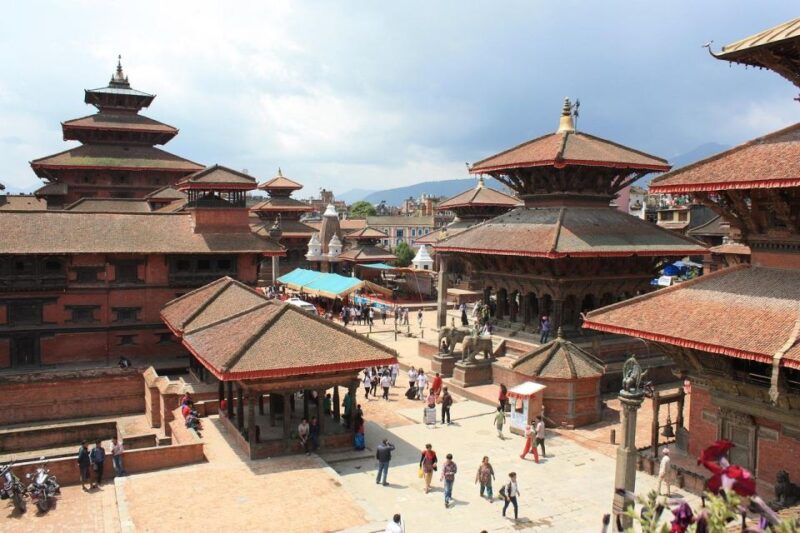
-
Explore the UNESCO World Heritage Kathmandu Durbar Square, featuring historic palaces, temples, courtyards, and intricate statues showcasing the city’s rich cultural heritage.
-
Visit the iconic Taleju Bhawani Temple, a 15th-century Hindu shrine standing at 40 meters tall with its distinctive pagoda-style architecture.
-
Discover the Gaddi Baithak, the former royal throne room offering insights into the grandeur of the Malla dynasty and Kathmandu’s political history.
-
Witness the sacred ritual of the living goddess Kumari at the Kumari Ghar, a temple renowned for its ornate woodcarvings and pagoda-style design.
-
Enjoy the cultural and religious significance of the Kaal Bhairab Shrine, featuring a colossal statue of the fierce deity who guards Kathmandu.
Exploring Kathmandu’s Historic Landmark
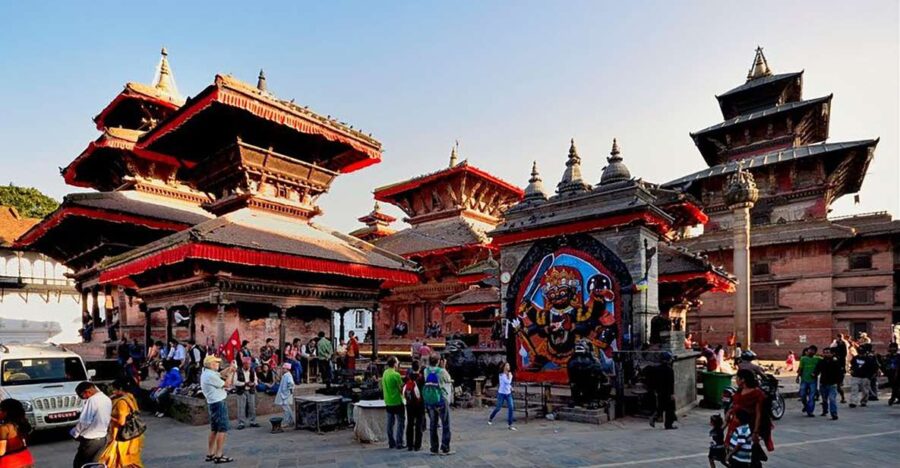
Kathmandu Durbar Square stands as a captivating testament to Nepal’s rich cultural heritage. This UNESCO World Heritage Site, nestled in the heart of Kathmandu, is a vibrant complex of historic palaces, temples, courtyards, and intricate statues.
Once the royal palace of the Malla kings, the square has long been a significant political, religious, and cultural center. Visitors can explore the ornate woodcarvings, pagoda-style temples, and the iconic Hanuman Dhoka Palace, the main attraction.
The bustling square offers a unique opportunity to take in Kathmandu’s living history, where the past and present seamlessly intertwine, captivating both locals and travelers alike.
You can also read our reviews of more tours and experiences in Kathmandu.
Discovering the Taleju Bhawani Temple
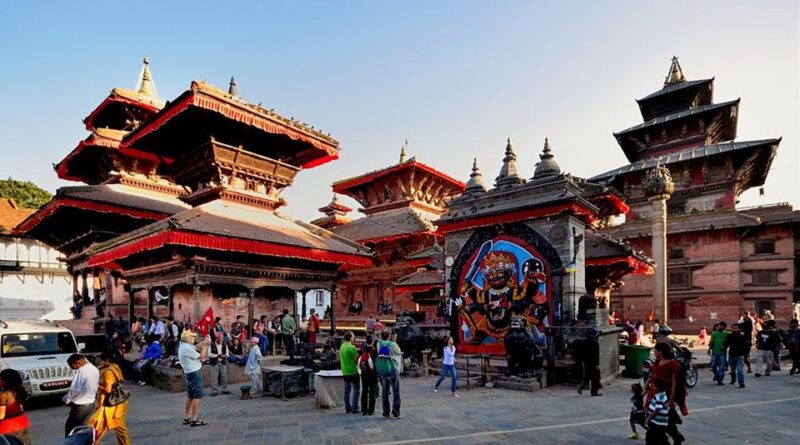
The Taleju Bhawani Temple stands as a hallmark of Kathmandu Durbar Square’s rich architectural tapestry. Dedicated to the Hindu goddess Taleju, this 15th-century temple boasts an impressive pagoda-style structure adorned with intricate woodcarvings and ornaments. Visitors can marvel at the temple’s unique blend of Nepalese and Newari influences, which have earned it recognition as a UNESCO World Heritage Site.
| Feature | Description |
|---|---|
| Height | 40 meters (131 feet) |
| Materials | Brick, stone, and wood |
| Architectural Style | Pagoda-style with multiple roofs |
| Significance | One of the most important Hindu temples in Kathmandu |
| Access | Open to the public, but entry restrictions may apply |
The Taleju Bhawani Temple is a must-see for any visitor seeking to enjoy the rich cultural heritage of Kathmandu.
Visiting the Gaddi Baithak
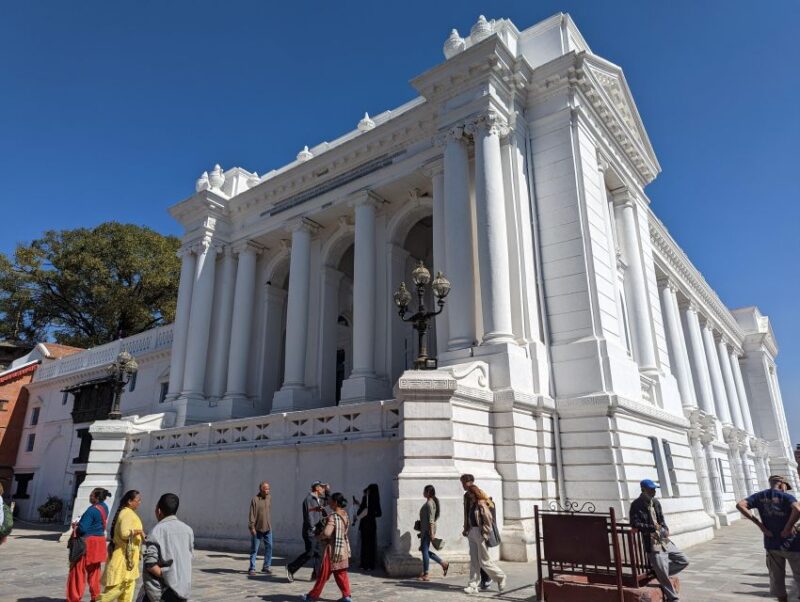
After exploring the Taleju Bhawani Temple, visitors can make their way to the Gaddi Baithak, a captivating royal pavilion within the Kathmandu Durbar Square complex.
This beautifully carved wooden structure served as a throne room for the Nepali monarchs. Adorned with intricate carvings and paintings, the Gaddi Baithak provides a glimpse into the grandeur of the Malla dynasty‘s reign.
Visitors can admire the fine craftsmanship and imagine the important political and ceremonial events that once took place here. The Gaddi Baithak offers a chance to delve deeper into Kathmandu’s rich history and gain a better understanding of the city’s cultural heritage.
Witnessing the Kumari Ghar
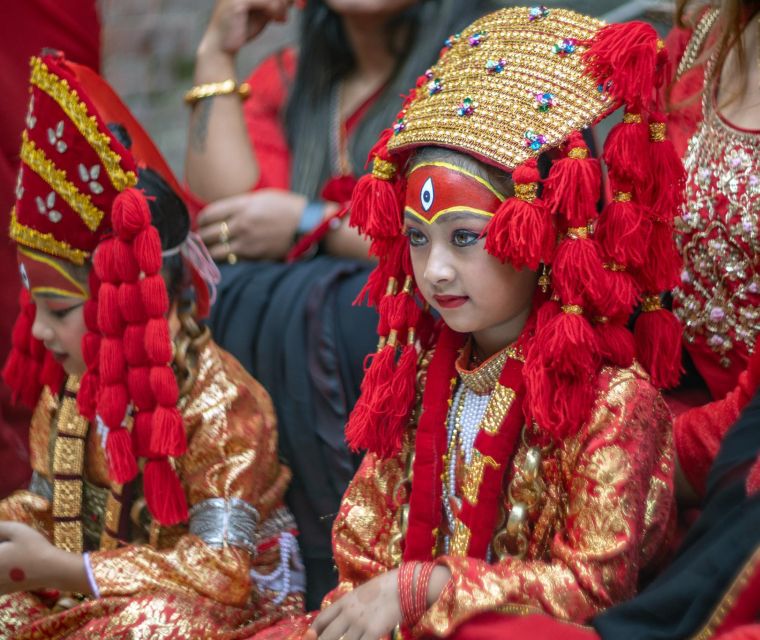
From the Gaddi Baithak, visitors can make their way to the enigmatic Kumari Ghar, a temple housing the living goddess of Kathmandu.
The Kumari is a young pre-pubescent girl believed to be the incarnation of the Hindu goddess Taleju. Visitors can witness the Kumari making appearances from the balcony, though her time is limited due to belief that her divinity will be lost if she touches the ground.
The temple’s intricate woodcarvings and pagoda-style architecture add to the mystical atmosphere.
Interacting with the Kumari is a rare opportunity, as she’s considered too sacred for casual conversations.
More Great Thing To Do NearbyTouring the Hanuman Dhoka Durbar
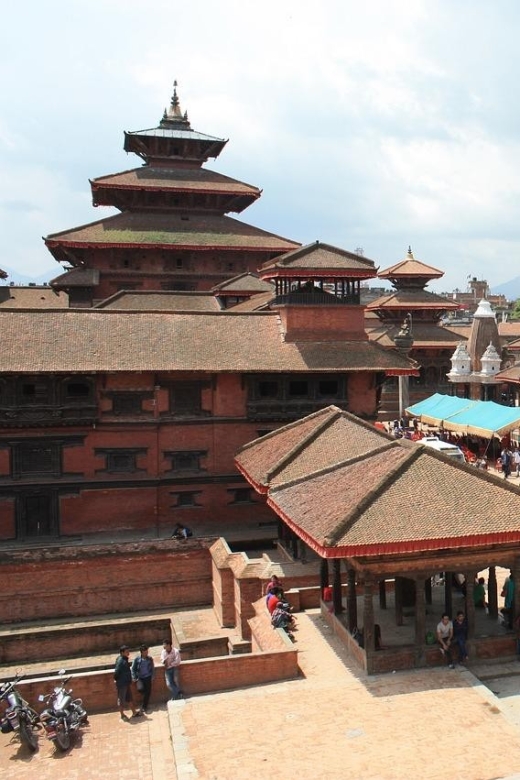
Visitors next make their way to the imposing Hanuman Dhoka Durbar, the former royal palace that once served as the seat of Nepali power.
This magnificent complex features an array of architecturally significant buildings, including the Gaddi Baithak, a grand audience hall adorned with intricate woodcarvings.
Nearby, the Kaal Bhairab shrine showcases a colossal statue of the fearsome deity.
The Trailokya Mohan Narayan Temple, with its distinctive pagoda-style roof, also draws the eye.
Wandering through the palace grounds, visitors can imagine the grandeur and importance of this historic site, which played a crucial role in Kathmandu’s rich cultural and political heritage.
Encountering the Kaal Bhairab
As they wander through the Hanuman Dhoka Durbar, visitors can’t help but be drawn to the Kaal Bhairab shrine. This towering bronze statue depicts a fierce manifestation of Shiva, the god of destruction. Revered by Hindus and Buddhists alike, Kaal Bhairab is considered the guardian of Kathmandu, protecting the city from evil forces.
-
The statue’s intense gaze and fearsome expression convey the power and might of this divine entity.
-
Devotees offer prayers, flowers, and other offerings at the shrine, seeking Kaal Bhairab’s blessing and protection.
-
The shrine’s location within the Durbar Square underscores the deity’s significance in the cultural and religious life of Kathmandu.
-
Encountering Kaal Bhairab is a profound and humbling experience, reminding visitors of the enduring spiritual traditions that shape the city.
Admiring the Kasthamandap Temple
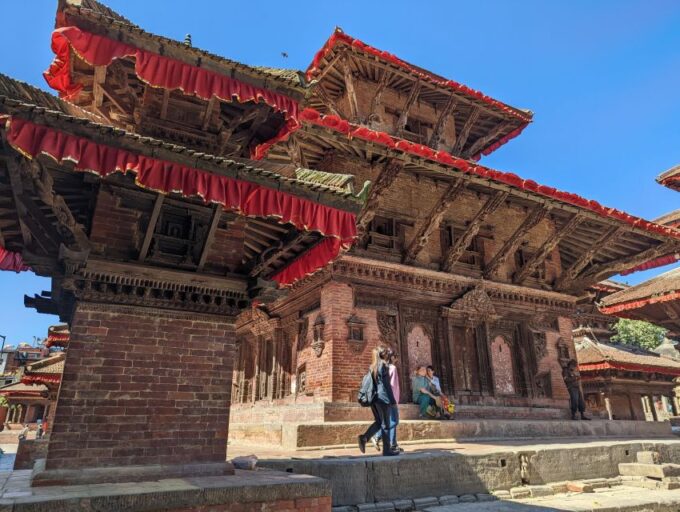
Near the Kaal Bhairab shrine stands the iconic Kasthamandap Temple, a masterpiece of Nepalese architecture and a defining landmark of Kathmandu Durbar Square.
Believed to have been constructed from a single tree in the 12th century, the temple’s intricate wood carvings and pagoda-style roof make it a stunning sight.
Visitors can explore the temple’s interior, admiring its ornate columns and the central shrine dedicated to the Hindu god Shiva.
The Kasthamandap is a testament to the skilled craftsmanship of Nepal’s past, and its presence adds to the rich tapestry of Kathmandu Durbar Square’s cultural heritage.
Visiting the Trailokya Mohan Narayan Temple
Situated at the northeastern corner of Kathmandu Durbar Square, the Trailokya Mohan Narayan Temple stands as a testament to the region’s rich cultural heritage.
This 17th-century shrine is dedicated to the Hindu deity Vishnu and features intricate woodcarvings, golden pagoda roofs, and a striking red facade.
Visitors can marvel at the temple’s architectural brilliance and learn about its historical significance, which includes:
- Its role as a center of religious worship and cultural practices
- The legends and myths associated with the temple’s construction and deities
- Its representation of the harmonious coexistence of different faiths in the region
- The temple’s enduring spiritual and aesthetic appeal to both devotees and travelers.
Frequently Asked Questions
Are There Any Security Restrictions for Entering the Sites?
There may be security restrictions for entering the sites, such as bag checks, no photography in certain areas, and dress code requirements. Visitors should be prepared to follow any guidelines or rules set by the site management.
Can I Take Photos Inside the Temples?
Yes, visitors are generally allowed to take photos inside the temples at Kathmandu Durbar Square. However, it’s important to be respectful of the sacred nature of the sites and follow any specific rules or restrictions that may be in place.
Are There Any Dress Code Requirements for Visitors?
Visitors are generally expected to dress modestly when visiting temples and religious sites in Nepal. Loose, lightweight clothing that covers the shoulders and knees is recommended. Hats, sunglasses, and shoes may need to be removed before entering certain sacred areas.
Is the Site Wheelchair Accessible?
The site is generally wheelchair accessible, though some areas may have stairs or uneven terrain. Visitors can explore most of the main sites and plazas, but may need assistance in navigating certain historic structures or temple entrances.
Are There Any Nearby Restaurants or Cafes?
There are several restaurants and cafes located near Kathmandu Durbar Square. Visitors can find a variety of local Nepali cuisines as well as international options within a short walking distance from the historic site.
Recap
Kathmandu Durbar Square is a captivating blend of history, spirituality, and cultural richness. Visitors can enjoy the intricate wood carvings, pagoda-style architecture, and the awe-inspiring presence of the living goddess Kumari. From the Taleju Bhawani Temple to the Kaal Bhairab Shrine, this UNESCO World Heritage Site offers a unique insight into Nepal’s enduring heritage, making it a must-visit destination for those seeking to explore Kathmandu’s vibrant and storied past.
You can check if your dates are available here:More Tour Reviews in Kathmandu
Not for you? Here's more things to do in Kathmandu we have recnetly reviewed
- 2 Best Guided Tours In Jagat
- 20 Best 2 Day Tours In Kathmandu
- 20 Best 3 Day Tours In Kathmandu
- 20 Best 4 Day Tours In Kathmandu
- 8 Best Dining Experiences In Kathmandu
- 20 Best Full-Day Tours In Kathmandu
- 25 Best Helicopter Flights And Tours In Kathmandu
- 25 Best Helicopter Flights And Tours In Kathmandu
- 13 Best Massage And Relaxation Services In Kathmandu
- 5 Best Photography Experiences In Kathmandu
- 8 Best Dinner Tours In Kathmandu
- 17 Best Lunch Experiences In Kathmandu
